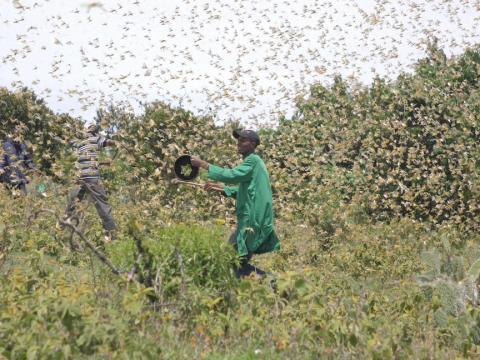By Martin Muluka, World Vision communication Specialist,Kenya
Five-year-old Nawal enjoys spending time at her mum’s shop in Tana River County, Kenya.
Her mother usually allows her to play with her siblings and friends outside the shop, as she attends to customers or buyers that flock the shop each day to purchase various products.
“I like my mother’s shop when I am not at school.Mum also gives me glucose and tea,” says Nawal cheerfully.
Her mother, Amina, is often filled with joy when she sees Nawal and her siblings happy. She does not take such delightful moments for granted, as she knows only too well how life situations can change from good to bad instantly.
In 2020, a swarm of locusts descended on her farm and destroyed all the crops that she had been banking on, to provide food for the family and generate additional income for household expenses.
"Locusts destroyed my farm. Life was difficult for us, especially my children, because we went for days without food,” recalls Amina.
She is among the many Kenyans in affected communities that bore the brunt of the desert locust infestation that first wreaked havoc in northern Kenya in March 2020.
A recent impact assessment by the Food Security and Nutrition Working Group, which is a regional platform for food security and nutrition analysis, indicates that approximately one-third of farmer households and one-half of livestock-rearing households in areas affected by desert locust infestations experienced crop and pasture losses from October to December 2020 in Kenya, Ethiopia and Somalia.

The Food and Agriculture Association (FAO) anticipates a new generation of locusts will emerge in early April 2021, coinciding with seasonal rains and the planting period in Kenya.This means that the desert locust menace is far from over.
There have been interventions by various organisations including World Vision to safeguard food production and prevent further food insecurity in the affected counties.
However, immature swarms continue to migrate westward through the northern, southern and central parts of the country.
Aside from Tana River, locusts have been reported in Garissa, Isiolo, Laikipia, Marsabit, Meru, Samburu, Tharaka and Wajir counties.
Additionally, scattered hopper bands continue to develop in Taita-Taveta County and along Kenya’s Indian Ocean coastline.
The science is simple: the more the locusts eat, the more they breed. And the more they breed, the further they have to swarm to find food.
Through the Tana River Desert Locusts Recovery Project, World Vision has been strengthening the capacity of government institutions and other key stakeholders to improve locust monitoring and forecasting systems, so as to aid preparedness and timely responses during emergencies.
To mitigate the impact of the locust outbreaks, boost food security and restore livelihoods, the organisation has also been supporting vulnerable crop farmers and pastoralists affected by the locust invasion in Tana River County.
This has been achieved through multi-purpose cash assistance, asset transfers and training communities on the Savings for Transformation (S4T) model by world Vision that is enhancing household economic recovery for affected families.
“World Vision gave us financial support. I was first trained on how to run a business and then given money. I used some to buy food for my children and then I started a shop since the nearest one used to be a kilometre away,” says Amina, who enjoys a ready market for her products.
Najma, one of Amina’s frequent customers notes: “This shop is the best because it is near. Before Amina opened this shop, I used to walk for long to get food to buy, but now I have more time to stay home and take care of my family. The prices are also friendly.
Just like Amina, Mwanahamisi’s farm was also destroyed by the locusts. Despite her loss, she still ventured into farming when she received money through World Vision’s cash transfer programme.This time round though, she was taught how to preserve fodder for her animals and use it during emergencies.
“When I got the money from World Vision, I bought goats. I have five goats that I milk. I received training on how to store grass for my goats during the drought and in case locusts eat up all the grass. I am happy because I get milk for my meals and sell the rest at the market,” says Mwanahamisi.
For Omar Juma, the cash transfer couldn’t have come at a better time. He used the proceeds to set up a barbershop. He uses the money generated from the business to sustain his family.
“For me, when I got the money, I opened a barbershop. The shaving machine is useful because I shave my own children, which enhances hygiene. In addition, my wife uses the space to do hair dressing. From the profits, we buy books for our children.
For sure, we are happy as a family because our lives are much better than before. Thank you so much World Vision for the support,” says Omar at Subo Village in Tana River County.
*Featured photo at the top: Amina and her daughter Nawal at their shop in Tana River County,Kenya. She set up the shop through the cash transfer support received from World Vision. ©World Vision photo/ Martin Muluka.

